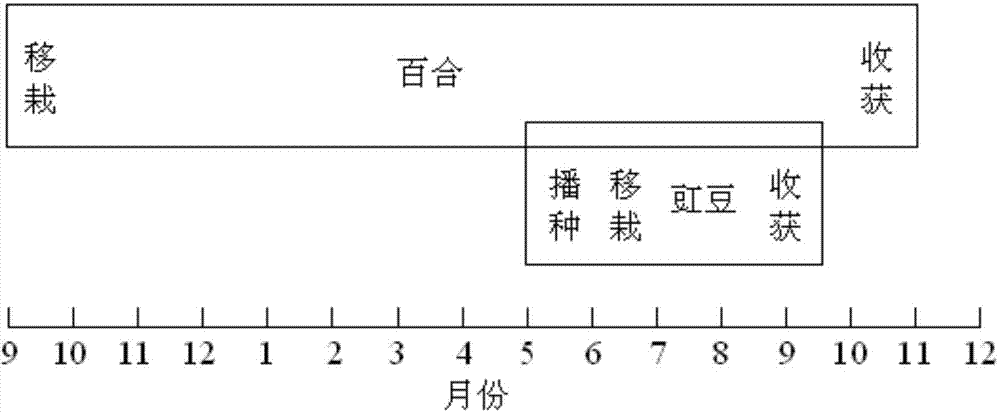Cultural method for interplanting lily with cowpea
A cultivation method and lily technology, applied in the field of crop cultivation, can solve the problems of no obvious control effect, unfavorable lily growth, and reduced land utilization rate, so as to reduce the harm of lily continuous cropping, increase annual economic benefits, and reduce production cost input.
- Summary
- Abstract
- Description
- Claims
- Application Information
AI Technical Summary
Problems solved by technology
Method used
Image
Examples
Embodiment 1
[0066] Embodiment 1: Lily interplanting cowpea optimal transplanting period selection test
[0067] Three lily varieties suitable for planting in sandy loam soil were selected: Longya Lily, Tiger Lily and Zhuzhouhong, and the selection experiment of the transplanting period of lily interplanting cowpea was carried out. On the 25th, July 1st, July 5th, July 10th and July 15th, the interplanting of cowpea was carried out. Lily adopts ditches and ridges for furrowing, furrow width 140-160cm, deep ditch digging 25-30cm on both sides of the furrow surface, and transplanting according to row spacing 35-45cm and plant spacing 15-20cm; Build a high ridge for cultivating cowpea scaffolds, 80-100cm wide, plant 2 rows of cowpea on the high ridge, plant 2-3 plants in each hole, and the distance between holes is 25-30cm. When the plants grow to 20-30cm and are about to vine, Insert the frame in time, use bamboo poles to form a "herringbone" shape, the height of the frame is 2.0-2.5m, inse...
Embodiment 2
[0072] Example 2: Experiments on the Effects of Different Planting Densities and Row Spacing on the Yield of Lily Interplanting Cowpea
[0073] Reasonable planting density of crops is the key technology to increase crop yield and efficiency. It is necessary to determine the parameters such as the width of the compartment, the spacing between the plants and the row spacing according to the planned output and marginal effects of the crops. Row spacing: the distance between rows when crops are cultivated in rows, and plant spacing: the distance between individual plants in a crop group.
[0074] Cowpea variety Cowpea suitable for intercropping of lily longya was used as the material, and the experiment was carried out in Xinhe Township, Huarong County, Hunan Province, and Wushenggong Town, Nanxian County, where the soil layer was deep, flat, rich in organic matter and abundant in fertility. Adopt ditching and ridges to make furrows, furrow width 140~160cm, dig deep ditch 25~30cm on...
Embodiment 3
[0081] Embodiment 3: the king of cowpea of the interplanting cowpea variety of lily variety Longya lily
[0082] Test location: Xinhe Township, Huarong County, Hunan Province.
[0083] Experimental group: Lilies are transplanted from September to October every year, and the furrows are made by ditching and ridges. The width of the furrows is 140-160 cm, and the deep grooves are dug on both sides of the furrow surface of 25-30 cm. The row spacing is 35-45 cm, and the plant spacing is 15-20 cm. Transplanting: Next to the deep ditch, set up a high ridge for building a scaffold for cultivating cowpea, with a width of 80 to 100 cm. On the high ridge, 2 rows of cowpea will be interplanted from late June to early July of the following year, and 2 rows of cowpea will be planted in each hole. ~3 plants, the hole distance is 25~30cm;
[0084] Lily net as control group: adopt local traditional planting method to plant lily alone;
[0085] Cowpea net as control group: adopt local trad...
PUM
 Login to View More
Login to View More Abstract
Description
Claims
Application Information
 Login to View More
Login to View More - R&D
- Intellectual Property
- Life Sciences
- Materials
- Tech Scout
- Unparalleled Data Quality
- Higher Quality Content
- 60% Fewer Hallucinations
Browse by: Latest US Patents, China's latest patents, Technical Efficacy Thesaurus, Application Domain, Technology Topic, Popular Technical Reports.
© 2025 PatSnap. All rights reserved.Legal|Privacy policy|Modern Slavery Act Transparency Statement|Sitemap|About US| Contact US: help@patsnap.com



